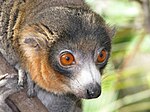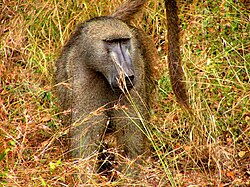The Primates Portal A primate is a member of the biological order Primates, the group that contains lemurs, the aye-aye, lorisids, galagos, tarsiers, monkeys, and apes, with the last category including great apes. With the exception of humans, who inhabit every continent on Earth, most primates live in tropical or subtropical regions of the Americas, Africa and Asia. Primates range in size from the 30-gram (1 oz) pygmy mouse lemur to the 200-kilogram (440 lb) mountain gorilla. According to fossil evidence, the primitive ancestors of primates may have existed in the late Cretaceous period around 65 mya (million years ago), and the oldest known primate is the Late Paleocene Plesiadapis, c. 55–58 mya. Molecular clock studies suggest that the primate branch may be even older, originating in the mid-Cretaceous period around 85 mya. Primates exhibit a wide range of characteristics. Some primates do not live primarily in trees, but all species possess adaptations for climbing trees. Locomotion techniques used include leaping from tree to tree, walking on two or four limbs, knuckle-walking, and swinging between branches of trees (known as brachiation). Primates are characterized by their large brains relative to other mammals. These features are most significant in monkeys and apes, and noticeably less so in lorises and lemurs. Many species are sexually dimorphic, which means males and females have different physical traits, including body mass, canine tooth size, and coloration.
Selected article
Lemurs are an infraorder of strepsirrhine primates that is endemic to the island of Madagascar. Although lemurs often are confused with ancestral primates, the anthropoid primates (monkeys, apes, and humans) did not evolve from them; instead, lemurs merely share morphological and behavioral traits with basal primates. Lemurs arrived in Madagascar approximately 62 to 65 mya by rafting on mats of vegetation at a time when ocean currents favored oceanic dispersal to the island. Since that time, lemurs have evolved to cope with an extremely seasonal environment and their adaptations give them a level of diversity that rivals that of all other primate groups. Until shortly after humans arrived on the island approximately 2,000 years ago, there were lemurs as large as a male gorilla. These subfossil lemurs were all larger than species living currently. Today, there are nearly 100 species of lemurs, and most of those species were discovered or promoted to full species status since the 1990s; however, lemur taxonomic classification is controversial and depends on which species concept is used. Living lemurs range in size from 30 g (1.1 oz) to 9 kg (20 lb). Lemurs share many common, basal primate traits, such as divergent digits on their hands and feet and nails instead of claws (in most species). However, their brain-to-body size ratio is smaller than that of anthropoid primates, and among many other traits they share with other strepsirrhine primates, they have a "wet nose" (rhinarium).
Selected picture The mandrill is the world's largest species of monkey. The word mandrill means "man-ape" according to the Oxford English Dictionary. CategoriesSelected species Least Concern (IUCN 3.1)|Least Concern The chacma baboon (Papio ursinus), also known as the Cape baboon, is from the Old World monkey family. It is one of the largest of all monkeys. Found primarily in southern Africa, the chacma baboon has a wide variety of social behaviors, including a dominance hierarchy, collective foraging, adoption of young by females, and friendship pairings. These behaviors form parts of a complex evolutionary ecology. In general the species is not threatened, but human population pressure has increased contact between humans and baboons. Hunting, accidents and trapping kill or remove many baboons from the wild. This has reduced baboon numbers and disrupted their social structure. Did you know?
Primate lists
WikiProjectsThings to do
Associated WikimediaDiscover Wikipedia using portals |
















